Tonsil Stones
What are Tonsil Stones?
Tonsil stones, known as tonsilloliths or tonsillar calculi, are dystrophic calcification formation in the tonsillar crypts or crevices.[1-4] They commonly form at the palatine tonsils, while some present at the lingual tonsils. In record, tonsil stones weigh about 0.3 to 42g. Tonsilloliths are common from age 20 to 77 years old [5]. The occurrence increases with age and uncommon among children.
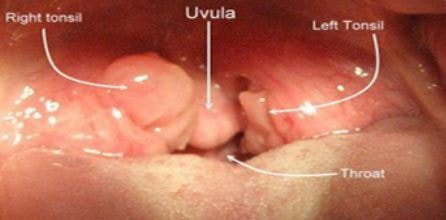

Tonsil stones appear as white or yellow stones made up of calcium salts like calcium carbonate apatite, oxalates, hydroxyapatite. The tonsillolith or magnesium salts, and some contain ammonium radicals. Tonsil stones present with a biofilm presentation, a clump of microorganisms adhering to a surface. The consistency of the stones can be soft, brittle to hard.[4,5,6]
In the French 2007 study, the researchers discovered that out of the 515 samples of CT scans, 6% or 31 subjects revealed the presence of calcified matter in their adenoids or nasopharyngeal tonsils. Because tonsil stones are not considered as a pathological case in most cases, few research literature have been published about the condition.[7,8]
What causes Tonsil Stones?
The exact cause and pathology of tonsil stones is unknown and the hypotheses of how the calculi stones formed are debatable. The incidence of tonsilloliths have been greatly associated with repeated or long standing oral infections. [5]
They could originate from repeated episodes of tonsillitis causing the development of excess tissues from the inflammation in the crevices and retention of tissue debris.[9] The tissue debris, then becomes a medium for the proliferation of bacteria and fungi. The accumulation of tissue debris and microorganisms in the tonsillar crevices leads to retention cyst formation. The lack of oxygen and the production of acid with the presence of sucrose or sugar further supports anaerobic bacterial growth.[6] With the deposition of the inorganic salts from the saliva, dystrophic calcification results. The deposited material grows gradually.
Some authors proposed another mechanism for the formation of stones in the peritonsilar area as secondary to the stasis of saliva within the minor salivary gland secretory ducts or due to the calcification of accumulated abscessified matters.[4] The carbonate and phosphate magnesium lime are derived from the saliva being secreted from the minor and major salivary glands.
Symptoms of Tonsil Stones
Tonsil stones can be asymptomatic. Incidentally, they can be discovered through radiographic procedures. More severe type cause an array of uncomfortable effects including pain in the neck and during swallowing, swollen tonsillar fossa, peritonsillar abscess,bad breath, otalgia, and and halitosis.[5,8]
Halitosis. Bad breath is one of the prime indicators of the presence of tonsil stone. In a study of patients using special test to determine the presence of volatile sulfur compounds in the subjects’ breath, 75% of people with high abnormal concentrations of the compounds have tonsillilith.[7]
Throat discomfort. Tonsil stones can cause local pain and discomfort. Protruding tonsillolith gives a sensation of the presence of foreign body stucked in the throat.[10] When tonsillitis and tonsil stones occur at the same time, it may be difficult to determine the cause of the pain, if it is due to the stone or the infection or both.
Palpable mass. Hard mucosal mass can be palpable in some cases at the submucosal or intratonsillar areas.
Dysphagia. With larger tonsil stones, it may be difficult and painful to swallow liquids and food.
Otalgia. Tonsils are being innervated by the glossopharyngeal nerve, thus, irritation and referred pain to the ear can be experienced.
Swollen tonsil. With the collection of debris in the tonsil crevices and formation of stones, inflammation of the tonsils due to infection and growth of the stones can occur.[9]
In diagnosing tonsillolith, the following criteria are being accounted for: anatomic localization, shape and number, and stone distribution. Some tonsil stones are hidden in the tonsil folds, while others can be visible as a mass of solid white material at the back of the throat. Diagnosing larger stones can be straight forward with the assessment of clinical manifestations.[11]
Radiographic studies include x-ray or CT scan. On x-ray, tonsillolith can be seen as a radio opaque shadows which can be misinterpreted as unerupted tooth, prominent maxillary tuber, calcified lymph node or foreign body.[4] CT scan provides for multiple axial views of the stone giving a confirmatory diagnosis. Dental panoramic radiographs show that tonsilloliths often occurs in the midline of the mandibular ramus where the back surface of the tongue meets the ramus in the palate-pharyngeal or palate-glossal space.[11]
How to get rid/remove of tonsil stones?
The majority of tonsil stones is small and asymptomatic without a need for treatment. Depending on the case, the stone can be managed surgically or non-surgically.
Home Management
Uncomplicated tonsil stones can be managed at home by dislodging the stones with swabs or picks. Salt water gargles can soothe tonsillitis with tonsillolith. Lemon juice and warm water gargle can also prevent the occurrence of the stones with the ascorbic acid content and saline bacterial inhibition effect. Using extra virgin olive oil for gargle can help alleviate inflammation. This can be used with or alternately with apple cider vinegar. Soft bristle toothbrush can also be used to gently massage and loosen the stones.[5,9]
Antibiotics
Antibiotics, such as amoxicillin, can be prescribed for infected cases. Antibiotics can destroy bacterial cell wall and inhibit bacterial proliferation. It could be a short term treatment of choice.[9]
Tonsil stones extraction
Small, symptomatic tonsil calculi can be manually removed under local anesthesia. Cryptolysis, with the use of laser, can also be used to remove the stones by removing the tonsil crypts.
Surgery
Surgical removal or tonsillectomy is advocated for large or impacted tonsil stones. Tonsillectomy is the management of choice or cryptic infection, but the stones has to be evaluated based on their morphology and biofilm nature in considering less invasive remedies.[6]
How to prevent Tonsil Stones?
Tonsilloliths are common in patients with chronic tonsillitis and sore throat. In such cases, the best way to prevent tonsil stone formation is through tonsillectomy. [12] Post nasal drip is also an associated contributory factor. Prevention and prompt treatment of the condition is another important step.[13]
To decrease or prevent the recurrence of tonsil stones, the following personal care are suggested: observe oral hygiene with proper brushing, flossing and use of mouthwash; gargling with warm, salt water to eliminate residual particles; drinking water to prevent drying of mucosa and washing debris from the crypts; and observing proper diet by minimizing or eliminating carbonated drinks and alcohol. Food with calcium that can facilitate stone development should be taken in moderation, such as dairy products.[12]
Pictures:
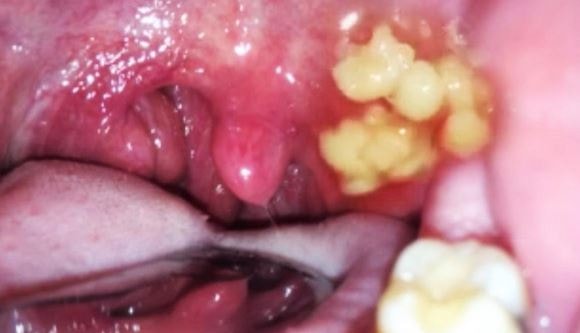
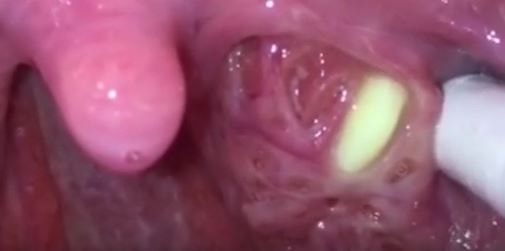

Multiple Tonsil Stones

Removed Tonsil Stone
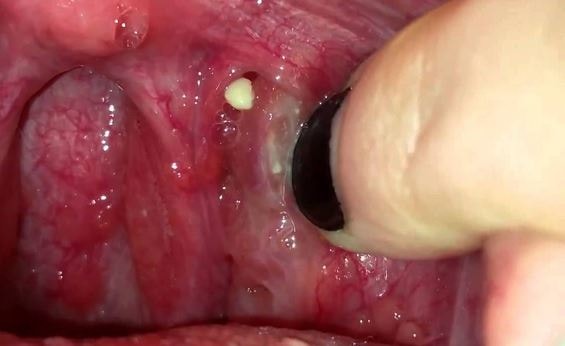
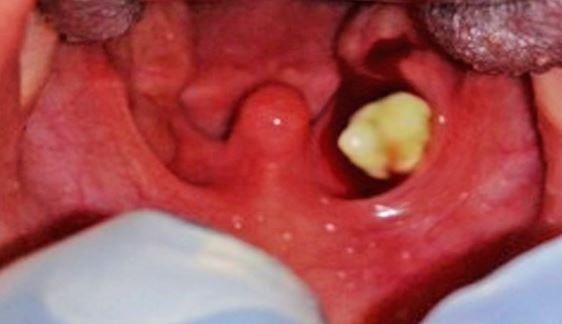
References
- Babu TA, Joseph NM. Persistent earache due to tonsillolith.Indian Pediatr. 2012 Feb; 49(2):144-5. PMID: 22410514. Available from http://www.indianpediatrics.net/feb2012/144.pdf
- Moura MDG, Madureira DF, Noman-Ferreira LC, Abdo EN, Aguiar EG, Freire ARS. Tonsillolith: A report of three clinical cases. Med Oral Patol Oral Cir Bucal 2007;12:E130-3. Available from http://www.medicinaoral.com/pubmed/medoralv12_i2_p130.pdf
- Ram S, Siar CH, Ismail SM, Prepageran N. Pseudo bilateral tonsilloliths: a case report and review of the literature. Oral Surg Oral Med Oral Pathol Oral Radiol Endod. 2014 July; 98 (1): 110–4. doi:1016/S1079210403007042. PMID15243480.
- Silvestre-Donat FJ, Pla-Mocholi A, Estelles-Ferriol E, MartinezMihi V. Giant tonsillolith: Report of a case. Med Oral Patol Oral Cir Bucal. 2005;10:239-42. Available from http://www.medicinaoral.com/medoralfree01/v10i3/medoralv10i3p239.pdf
- Thakur JS, Minhas RS, Thakur A, Sharma DR, Mohindroo NK. Giant tonsillolith causing odynophagia in a child: a rare case report. Cases Journal. 2008;1:50. doi:10.1186/1757-1626-1-50. Available from http://www.ncbi.nlm.nih.gov/pmc/articles/PMC2491595/
- Stoodley P, Bebeer D, Longwell M, Nistico L, Hall-Stoodley L, Wenig B, Krespi YP. Tonsillolith not just a stone but a living biofilm. Otolaryngol Head Neck Surg. 2009 September; 141(3): 316–321. doi: 10.1016/j.otohns.2009.05.019
- Salem DB, Gulu B, Duvillard C, Couaillier JF, Ricolfi F. Nasopharyngeal tonsillolith: a report of 31 cases. Journal De Radiologie. 2007 February, 88(2): 259-262. doi: JR-02-2007-88-2-0221-0363-101019-200609819. Available from http://www.em-consulte.com/article/122123/alertePM
- Svoboda, Elizabeth. In Tonsils, a Problem the Size of a Pea. The New York Times. 2009 September. Available from http://www.nytimes.com/2009/09/01/health/01tons.html?_r=0
- Friedman M. Tonsil stones (tonsillolith). WebMD, LLC. 2015 November. Available from http://www.webmd.com/oral-health/guide/tonsil-stones-tonsilloliths-treatment-and-prevention?page=2
- Tsuneishi M, Yamamoto T, Kokeguchi S, Tamaki N, Fukui K, Watanabe T. Composition of the bacterial flora in tonsilloliths. Microbes Infect. 8 (9–10): 2384–9.doi:10.1016/j.micinf.2006.04.023. PMID16859950.
- Aghdasi MM, Valizadeh S, Amin-Tavakoli N, Bakhshandeh H. Tonsilolith in Routine Panoramic Radiographies; Is It a Common Incidental Finding? Iranian Journal of Radiology. 2012;9(2):109-110. doi:10.5812/iranjradiol.7563. Available from http://www.ncbi.nlm.nih.gov/pmc/articles/PMC3522351/
- Bell A. Tuesday Q&A: self-care steps may help prevent tonsil stones from returning. Mayo Clinic. 2014 October. Available from http://newsnetwork.mayoclinic.org/discussion/tuesday-q-and-a-self-care-steps-may-help-prevent-tonsil-stones-from-returning/
- Bradford A. Tonsil stones: causes, removal and prevention. Live Science. 2014 May. Available from http://www.livescience.com/50847-tonsil-stones.html.
